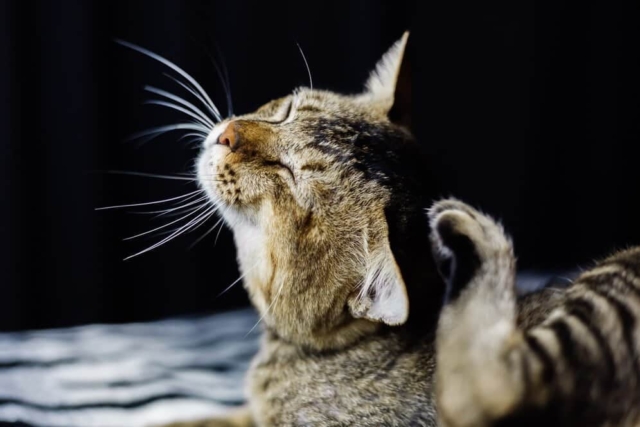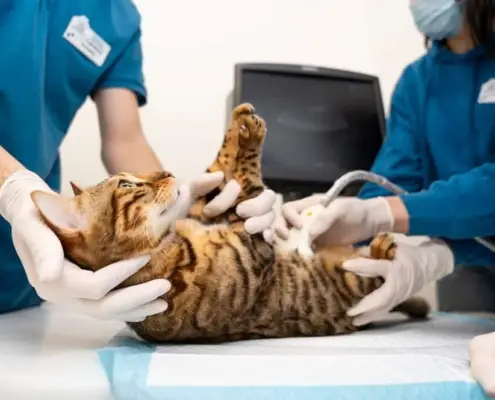
Cats are known for their pristine grooming habits, but sometimes even the most diligent feline can develop skin problems. As responsible pet owners, it is crucial to understand the common skin issues that can affect our furry friends. By recognizing the signs and symptoms, we can take the necessary steps to provide relief and prevent further complications.
One of the most prevalent skin problems for cats is dermatitis, which refers to inflammation of the skin. This condition can be caused by various factors, including allergies, parasites, infections, and even underlying health conditions. Another common issue is feline acne, characterized by the formation of blackheads and pustules on the chin and lips. Other skin problems that afflict cats include ringworm, hot spots, and mites.
Causes of Skin Problems in Cats
Skin problems in cats can arise from a multitude of causes. Allergies, both environmental and food-related, are a primary culprit. Cats can be hypersensitive to substances like pollen, dust mites, or certain ingredients in their diet, leading to intense itching and skin irritation. Additionally, parasites such as fleas, ticks, and mites can infest a cat’s fur, causing severe discomfort and skin problems.
Infections, both bacterial and fungal, can also contribute to skin issues. Bacterial infections can occur due to a weakened immune system or as a secondary infection resulting from another underlying condition. Ringworm, a fungal infection, is highly contagious and can spread rapidly among cats. Other factors that can trigger skin problems include hormonal imbalances, stress, poor nutrition, and even excessive grooming habits.
Symptoms of Skin Problems in Cats
Identifying the symptoms of skin problems in cats is crucial for prompt intervention and treatment. Cats may exhibit various signs of skin issues, including excessive scratching, biting, or licking of certain areas. They may develop scabs, redness, or swelling on the skin. Hair loss, especially in patches, is another common symptom. In some cases, cats may experience a change in their skin color or texture. Persistent itching and discomfort can lead to behavioral changes, such as irritability or restlessness.
It is worth noting that some cats may be asymptomatic, making it challenging to detect skin problems. Regularly inspecting your cat’s skin and coat, especially during grooming sessions, can help identify any abnormalities early on. If you notice any concerning signs, it is essential to consult a veterinarian for a proper diagnosis and treatment plan.
Diagnosing Skin Problems in Cats
When confronted with a cat experiencing skin problems, a veterinarian will employ various diagnostic methods to determine the underlying cause. The initial step usually involves a thorough physical examination of the cat’s skin and coat. The veterinarian may use a specialized tool called a Wood’s lamp to detect fungal infections like ringworm.
In cases where the cause is not evident, further tests may be necessary. Skin scrapings or swabs can be taken to check for the presence of parasites, bacteria, or fungi. Blood tests may also be conducted to assess the cat’s overall health and identify any underlying conditions that may be contributing to the skin problems.
It is important to provide the veterinarian with a detailed history, including any recent changes in the cat’s environment, diet, or exposure to potential allergens. This information can greatly assist in the diagnosis and subsequent treatment of the skin problems.
Treating and Managing Skin Problems in Cats
Once a diagnosis has been made, the veterinarian will recommend an appropriate treatment plan tailored to the specific skin problem. The treatment approach may vary depending on the underlying cause, severity of the condition, and the cat’s overall health.
In cases of allergies, identifying and eliminating the allergen from the cat’s environment or diet is crucial. Antihistamines or corticosteroids may be prescribed to provide temporary relief from itching and inflammation. Regular bathing with a gentle, hypoallergenic shampoo can help soothe the skin and remove any irritants.
For bacterial or fungal infections, topical or oral medications may be prescribed. These medications can include antibiotics, antifungals, or a combination of both. It is important to follow the veterinarian’s instructions carefully and complete the full course of treatment to ensure effective eradication of the infection.
In some cases, additional measures may be necessary to manage the cat’s skin problems. This can include the use of medicated sprays or creams, dietary supplements to support skin health, or even changes in the cat’s grooming routine. Regular check-ups with the veterinarian will be essential to monitor the cat’s progress and make any necessary adjustments to the treatment plan.
Natural Remedies for Cat Skin Problems
While veterinary care is crucial for treating and managing cat skin problems, some natural remedies can be used as complementary therapies. These remedies can help soothe the skin, reduce itching, and promote overall skin health. However, it is important to consult with a veterinarian before incorporating any natural remedies into a cat’s treatment plan, as some ingredients may be harmful or interact with prescribed medications.
One natural remedy often recommended for cat skin problems is oatmeal. Oatmeal baths can help alleviate itching and inflammation. Colloidal oatmeal, available in various pet-specific products, can be added to warm water for a soothing soak. Additionally, coconut oil can be applied topically to moisturize the skin and provide relief.
Certain herbal remedies, such as calendula, can have anti-inflammatory and soothing properties. These herbs can be used in the form of a diluted tea, which can be applied to the affected areas or used as a rinse after bathing. Aloe vera gel, known for its healing properties, can also be beneficial when applied to irritated skin.
While natural remedies can provide temporary relief, it is important to address the underlying cause of the skin problem with veterinary guidance. Natural remedies should always be used in conjunction with veterinary care for optimal results.
Preventing Skin Problems in Cats
Prevention is key when it comes to cat skin problems. By implementing a few simple measures, you can significantly reduce the risk of your cat developing skin issues. Regular grooming is essential to maintain a healthy coat and skin. This includes brushing to remove loose hair and debris, as well as checking for any signs of skin problems or parasites.
A balanced and nutritious diet is crucial for overall health, including skin health. Ensure that your cat’s diet is complete and provides all the necessary nutrients. If your cat has known food allergies, work with your veterinarian to identify and eliminate any potential triggers from their diet.
Maintaining a clean and stress-free environment is also important. Regularly clean your cat’s bedding and living areas to minimize the presence of allergens, parasites, or bacteria. Provide adequate opportunities for exercise and mental stimulation to reduce stress levels, as stress can contribute to skin problems.
Best Practices for Cat Grooming and Hygiene
Proper grooming and hygiene practices are essential for maintaining a cat’s skin health. Regular brushing helps remove dead hair, prevents matting, and stimulates the production of natural oils that keep the skin moisturized. The frequency of brushing will depend on your cat’s coat type, but aim for at least a few times a week.
Bathing should be done sparingly, as cats are generally adept at self-cleaning. However, in cases of skin problems or excessive dirt accumulation, a bath with a gentle, cat-specific shampoo may be necessary. Always use lukewarm water and ensure that the cat is comfortable throughout the process. After bathing, thoroughly dry your cat to prevent moisture from causing further skin issues.
Nail trimming is another important aspect of grooming. Overgrown nails can cause discomfort and contribute to skin problems if they scratch or injure themselves. Regularly check your cat’s nails and trim them as needed, being careful not to cut too close to the quick.
Lastly, it is essential to regularly check your cat’s ears and teeth. Look for any signs of redness, discharge, or foul odor in the ears, as these may indicate an infection. Brushing your cat’s teeth regularly can help prevent dental issues that can indirectly affect the skin.
When to See a Veterinarian for Cat Skin Problems
While some mild skin problems can be managed at home, there are instances where veterinary intervention is necessary. If your cat’s skin problems persist or worsen despite home care, it is crucial to seek professional help.
Additionally, certain symptoms should prompt immediate veterinary attention. These include severe itching that leads to self-inflicted wounds, extensive hair loss, open sores, or signs of infection such as swelling, pus, or a foul odor. If your cat is experiencing discomfort or there is a sudden change in their behavior, it is best to consult a veterinarian promptly.
Remember, early intervention and proper diagnosis are crucial for successful treatment and management of cat skin problems. A veterinarian can provide the necessary expertise and guidance to ensure your feline companion receives the care they need.
Conclusion
Skin problems in cats can be a source of discomfort and distress for both the cat and their owner. By familiarizing ourselves with the common causes, symptoms, and treatment options, we can take proactive steps to prevent and manage these issues. Regular veterinary care, including routine check-ups and vaccinations, is essential for maintaining your cat’s overall health and well-being.
Remember, if your cat is experiencing any skin problems, it is always best to consult with a veterinarian for a proper diagnosis and treatment plan. With the right care and attention, we can help our feline friends overcome their skin problems and enjoy a healthy, happy life.
If you suspect your cat may be suffering from skin problems, don’t hesitate to consult a veterinarian. Your cat’s well-being and comfort are our top priorities. Contact us today to schedule an appointment and ensure your feline friend receives the care they need.
If you enjoyed my article, I would appreciate you sharing it with your network.

Sima Ndlebe
Sima writes for CatBuzz. He is interested in Cats, Health and Fitness, and Entrepreneurship.
Published: 11 October 2023
Related Articles
Disclaimer
The content found on CatBuzz.org is presented on an "as is" basis and is intended for general consumer information and education purposes only. Any utilization of this information is voluntary and solely at the user's own risk.
None of the articles or content should be regarded as, or used in place of, veterinary medical advice, diagnosis, or treatment. The information provided on the website is purely for educational and informational intentions and should not be considered a substitute for professional guidance from a veterinarian or other qualified expert. The articles are designed to inform consumers about veterinary healthcare and medical matters that may impact their cat's daily life. It should be noted that this website and its services do not constitute the practice of any form of veterinary medical advice, diagnosis, or treatment. CatBuzz.org explicitly disclaims any liability for any direct or indirect damages or losses that may arise from the use of or reliance on the information contained within the content.
Consumers must consult a veterinarian, veterinary specialist, or another qualified veterinary healthcare provider when seeking advice regarding their cat's health or medical conditions. It is important not to ignore, avoid, or postpone seeking medical advice from a veterinarian or other qualified veterinary healthcare provider solely based on information obtained from this website. If you believe that your cat may be experiencing a medical issue or condition, it is imperative to promptly contact a qualified veterinary healthcare professional.



